If your doctor has diagnosed you with prostatic intraepithelial neoplasia (PIN), many questions are probably racing through your mind. We hope you get detailed answers to all of them, but in case you don’t, or you don’t ask, or you just want to know more, read on.
What is prostatic intraepithelial neoplasia?
PIN is a blanket term for a condition in which some prostate cells—the epithelial cells in the prostate that line the tiny sacs called acini and those that line the ducts that transport fluid to the ejaculatory duct–look and behave abnormally. However, even though the epithelial cells that line these features become abnormal, the linings themselves do not change. The abnormalities also do not encroach into other surrounding tissue.
PIN does not present with symptoms; doctors do not detect it during a digital rectal exam (DRE) nor does the condition cause an elevated prostate-specific antigen (PSA) level. Rather it is generally discovered when a man undergoes a prostate biopsy or transurethral resection of the prostate (TURP) and the prostate tissue is examined under a microscope. Typically, a prostate biopsy consists of the clinician taking several samples (cores) of prostate tissue from various areas of the gland.
How is PIN classified?
PIN may appear in some men in their twenties, and nearly 50 percent of all men will have this abnormality by the time they reach their fifth decade. Based on how the abnormal cells look, PIN can be classified into one of two categories:
- Low-grade PIN, which means the prostate cells look nearly normal. This form of PIN is considered to be insignificant and does not lead to prostate cancer.
- High-grade PIN, which means the prostate cells are more abnormal. This form has the potential to develop into prostate cancer over time, but not necessarily so. The American Cancer Society estimates that 4 to 8 percent of men who undergo a prostate biopsy will be diagnosed with high-grade PIN. Research also suggests African American men are more likely to have high-grade PIN than are white men
What about PIN and prostate cancer?
If a man with PIN develops prostate cancer, what happens is that the epithelial linings rupture and the cancerous (malignant) cells infiltrate the prostate gland tissue. In most cases, high-grade PIN doesn’t turn into prostate cancer over the next few years after diagnosis. However, the risk of developing cancer is greater if high-grade PIN is identified in more than one biopsy core.
Let’s focus on high-grade PIN, since it is the one that is more likely to progress to prostate cancer. Several reasons have been identified for this cancer progression.
- Research shows that 82 percent of prostate specimens with prostate cancer also showed signs of high-grade PIN compared with only 43 percent of individuals without prostate cancer
- High-grade PIN is more likely to appear in the area of the prostate where most prostate cancer develops: the peripheral zone of the prostate
- The nuclei of high-grade PIN cells are often enlarged and some of their components are abnormal, which may contribute to abnormal behavior that can promote malignancy (cancer)
- Cells that characterize high-grade PIN have many of the same molecular and genetic features that cancer cells do
Another important feature of high-grade PIN is that it seems to precede the development of cancer by 5 years in older men and by 10 years in younger ones. The good news is there appears to be only a slightly elevated risk of developing prostate cancer among men with high-grade PIN.
How do you treat high-grade PIN?
Experts do not agree on exactly how to manage high-grade PIN. One hurdle is a lack of understanding about what would happen if you do nothing. Another is that traditional screening tests for prostate cancer (i.e., digital rectal exam, PSA, transrectal ultrasound, family history) are not reliable for discovering which man with high-grade PIN will eventually develop prostate cancer.
A general recommendation is to adopt a wait-and-see approach. Some clinicians recommend their patients undergo follow-up prostate biopsies at some regular intervals; for example, every six months, 12 months, or every two years. The frequency will depend on the degree of risk. Some men, for example, have numerous cores showing high-grade PIN, while others may have only one or two.
Adoption of healthy lifestyle choices also is recommended to help manage high-grade PIN. These include following a whole, natural diet, exercising regularly, managing stress, maintaining a healthy weight, limiting alcohol use, getting sufficient sleep, staying sexually active, and keeping hormones in balance.
References
Chornokur G et al. High grade prostate intraepithelial neoplasia (PIN) is a PSA-independent risk factor for prostate cancer in African American men: results from a pilot study. Cancer Letters 2013 May 1; 331(2): 154-57
National Cancer Society. Understanding your pathology report







